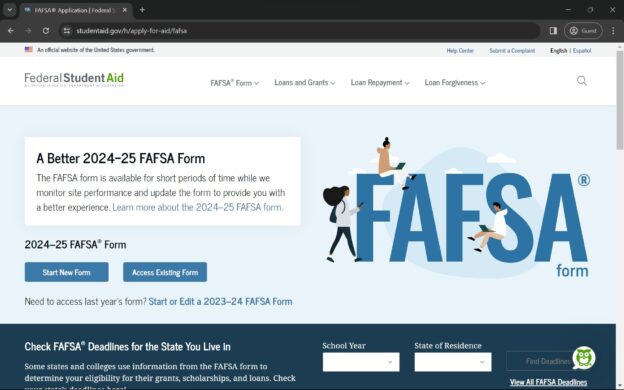The U.S. Department of Education launched a new version of the Free Application for Federal Student Aid [FAFSA] form. The form has had several delays, glitches, and mistakes in the formula. Students, families, and financial aid offices have had difficulty with the new system.
By Ayla Ozturk
The United States Department of Education [USDE] recently overhauled the Free Application for FAFSA form to comply with the FAFSA Simplification Act. However, the form has many issues hindering the intended simplification.
The 2024-2025 FAFSA form was made available for a soft launch on December 31, 2023. By law, the FAFSA must be available by January 1.
At the start, the timing of the form’s availability was unpredictable. It would be available for specific periods and then shut down for “scheduled maintenance.” At the start, the form was open for as little as 30 minutes at a time.
Students were not given estimated times for the maintenance. If they were to go to the website to complete the form and it was not open, they would not know when to check back.
While the form is available 24/7 now, the USDE states they still may occasionally close access to the FAFSA form to “perform maintenance and improve the user experience.”
On Wednesday, January 17, Representative Bobby Scott, who was a lead sponsor and negotiator of the FAFSA Simplification Act, submitted a letter to the USDE expressing his concerns.
On Thursday, January 25, the National Association of Student Financial Aid Administrators [NASFAA] reported a call to investigate the launch by lawmakers.
In a letter to the U.S. Government Accountability Office, Representative Virginia Foxx and Senator Bill Cassidy expressed their concerns about the launch.
“The goal of FAFSA simplification was in part to make the whole process easier for students and their families,” the letter states. “This is possible only if Education is providing students with clear communications on how to navigate the new application.”
The letter was signed by 26 other lawmakers.
Delays and Financial Aid Offices
The 2024-2025 FAFSA has experienced several delays. These delays take a toll on financial aid offices around the country.
David Loverin is the Financial Aid Director at College of the Sequoias [COS]. His office processes FAFSA forms and builds financial aid packages according to federal guidelines.
In recent years, the FAFSA opened in October to give colleges adequate time to process financial aid applications. This year, it opened two months later than usual, just before the legal deadline.
Financial aid is an important factor for many students when it comes to choosing which college to attend. Because of the delays, they have less time to make that decision.
Loverin says, “Instead of being able to tell the student what they’re going to receive in aid right now, we may not be able to give students that information as soon as in prior years, maybe till April or May at best.”
COS uses a software company called Ellucian to process financial aid applications. Due to the change in formula, the software needs to be rebuilt to adhere to the new guidelines.
“We’re just kind of already expecting it to be a very crazy spring semester. We’re still paying and processing our students for the current year, but we’re also trying to learn a whole new way of awarding and processing financial aid applications,” Loverin says.
“We’re trying to learn and study the whole new way of doing everything so that we can best answer student questions or best help the students,” Loverin says. “Just have patience with the college that you’re communicating with because it’s a learning year for even the colleges.”
Student Experiences
Yaretza Martin, ’24, is a senior at Redwood. She says, “[The delays] cause a lot of stress for a lot of people because some people have to know whether they are or aren’t going to get that money. They have to know ahead of time to be able to plan out where they want to go.”
Daniela Ceballos, ’24, is also a senior. She says, “[The delays are] just a struggle because it just gives you more anxiety around how you want to plan out your future.”
“It was hard to create the [FSA ID] for my mom because she had to do multiple steps, and she didn’t know how to do it,” she says. “I didn’t know how to help.”
Martin shares this experience, as her parents are from Mexico. She will be the first person in her family to attend college.
“[Ceballos’s experience] was similar to my parents too, because they’re not from here,” she says. “It’s very complicated.”
Despite the USDE’s intention to make the FAFSA easier to fill out, some students still find it confusing.
Martin says, “[The FAFSA is] very complicated. I feel like they should make it a lot simpler. Because at the end of the day, at least for the people who are doing it for the first time, we’re just high school students.”
A Mistake in the Formula
Last December, the Washington Post reported a major issue in the new FAFSA formula: the numbers were not being adjusted for inflation.
When Congress passed the FAFSA Simplification Act in 2020, the legislation required the USDE to utilize income protection allowance take take inflation into account. However, they did not do this.
NASFAA reportedly alerted the USDE of this issue in October 2023.
The USDE did not indicate whether or not they would fix the issue until last week.
On Tuesday, January 23, the USDE announced they would work on the issue. However, it did not give a timeline of when or how the adjustments will be implemented and if this will impact their distribution of ISIRs to institutions at the end of January as originally stated.
The ISIR [Institutional Student Information Record] includes data from FAFSA forms. It is sent to the colleges students request on the form.
The USDE could either delay sending ISIRs to colleges after making adjustments, or it could begin sending the information to start preparing initial financial aid offers. The initial offers would need to be updated once the formula is adjusted.
According to the USDE, students would miss out on $1.8 billion in federal aid if the issue is not fixed in time.
Read more about this issue in our previous coverage.
Undocumented Families
Issues also arise when undocumented families fill out the form.
To fill out the FAFSA, you need a Federal Student Aid ID [FSA ID]. To create one, you need a social security number, which undocumented individuals do not have.
It is possible to get an FSA ID without a social security number by verifying your identity with a U.S. driver’s license, State/City ID card, or foreign passport.
Another option is a utility bill matching the information inputted on the FSA ID request along with a municipal ID card, community ID, or consular ID card.
In California, undocumented individuals can get an AB 60 driver’s license, but that is not the case in all states.
Additionally, families may face barriers to acquiring identification, such as not having documents like birth certificates that are required to apply for it.
Some states have specialized programs for undocumented students. In California, undocumented students qualify for the California Dream Act Application [CADAA].
Resources are available at the California Student Aid Commission website. Find information on AB 60 driver’s licenses here.
Tags: 2024-2025 fafsa changes, ayla ozturk, FAFSA, fafsa soft launch, news, rangers, Redwood, redwood gigantea, redwood high school, redwood journalism, redwood news, redwood rangers, rhs, visalia ca


